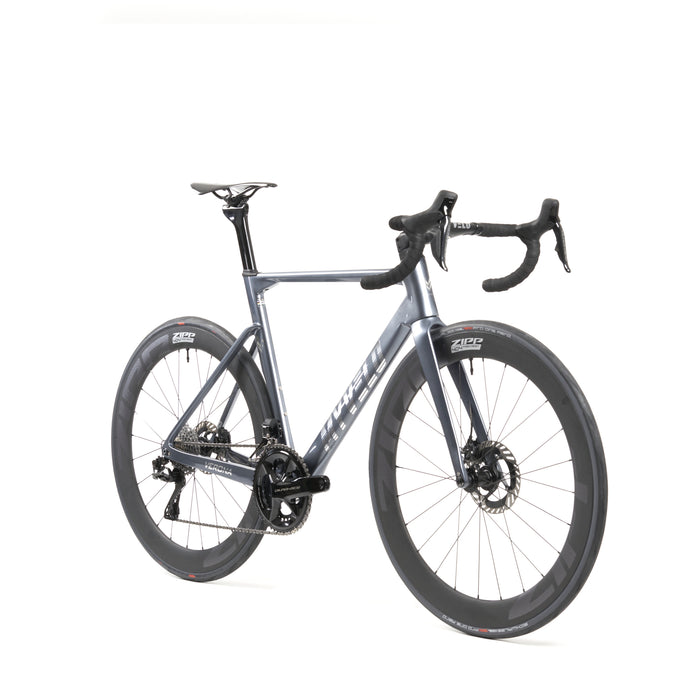
Verona road bike
incl. FREE shipping & free returns

The world of training is constantly offering new methods that claim to work miracles. One of these methods is blood flow restriction training (BFR). It sounds promising: By partially cutting off blood flow to the muscles, they are said to grow faster, and endurance performance, measured by VO2 max, could also benefit. However, for road cyclists, this technique carries significant risks that are often underestimated.
Von Fabian Huber |
2 minutes read time

In BFR, special cuffs or bands are placed around the arms or legs to reduce blood flow. The goal is to block venous return while largely maintaining arterial blood flow. This leads to an accumulation of metabolic waste products in the muscles, which is intended to increase the training stimulus – even with low exertion. BFR triggers mechanisms that normally only occur during intensive training:
The method is often used in strength training or rehabilitation and promises rapid progress with minimal effort. For road cycling, there is discussion about whether BFR can also improve VO2 Max, which is considered a key indicator of cardiovascular performance. But before strapping on the cuffs, one should carefully consider the potential dangers.
Although the method is receiving more attention, it poses serious health risks, especially for amateur road cyclists who attempt it without professional guidance. Here are the biggest dangers:
Increased risk of thrombosis: The deliberate clamping of blood flow can promote the formation of blood clots. If these clots enter the bloodstream, they can have potentially life-threatening consequences, such as pulmonary embolisms or strokes. The risk is particularly high for people with a genetic predisposition or pre-existing conditions such as varicose veins.
Incorrect use: Without professional guidance, there's a risk of applying the cuffs too tightly. This can not only completely block blood flow but also cause tissue damage and nerve damage.
Lack of Benefit for Amateur Athletes The benefits of BFR training have primarily been studied in rehabilitation or competitive sports. For amateur road cyclists, who often don't train at their maximum endurance limit anyway, there is little scientific evidence of any additional benefit.
Psychological stress: The unfamiliar tightness and pressure of the cuffs can be uncomfortable and stressful. Instead of enjoying the workout, recreational athletes may associate cycling with discomfort.
Instead of relying on potentially dangerous methods like BFR training, there are numerous proven and safe ways to increase VO2Max:
Interval training: High-intensity interval training (HIIT) is one of the most effective methods for improving maximum oxygen uptake. Alternating between short, intense bursts of exercise and recovery phases gets your cardiovascular system working.
Basic endurance training Long, relaxed sessions at low intensity improve aerobic capacity and create a stable foundation for more intense exercise.
Strength training Supplementary strength training, especially for the leg muscles, ensures greater efficiency on the bike and supports overall performance.
Nutrition and recovery A balanced diet and adequate recovery are key factors for making progress and avoiding injuries.
Blood flow restriction training may have its place in rehabilitation or professional competitive sports, but for recreational road cyclists, the risks far outweigh the benefits. Thrombosis, tissue damage, and potential misuse are serious dangers that far outweigh any potential benefits.
If you want to increase your VO2 Max, opt for proven training methods like interval training and basic endurance training. These are not only safer but also offer more sustainable results in the long run – without the need for wristbands or unnecessary risks.

Gravelbikes sind in den letzten Jahren zu echten Allroundern auf dem Fahrradmarkt geworden. Sie kombinieren die Sportlichkeit eines Rennrads mit der Robustheit eines Mountainbikes und sind ideal für alle, die sowohl auf Asphalt als auch auf Schotterwegen unterwegs sein wollen. Doch gerade Einsteiger stellen sich oft die Frage: Bekommt man ein gutes, modernes Gravelbike schon für unter 1000 Euro? Die Antwort lautet: Ja – wenn man weiß, worauf es ankommt.

Wer viel Rennrad fährt, kennt das Gefühl: Anfangs ist alles wunderbar – der Wind pfeift, die Beine laufen, die Strecke ist dein Element. Doch nach einer Stunde meldet sich dein Hintern. Erst leicht, dann stechend, schließlich so brennend, dass jeder Tritt zur Qual wird. Willkommen im Club: Satteldruck und gereizte Haut gehören zu den häufigsten Beschwerden unter Radfahrer*innen – und kaum jemand spricht offen darüber.
Zeit, das Tabu zu brechen.

For many, coffee is as much a part of their morning routine as a racing jersey is to their bike. But did you know that caffeine is much more than just a stimulant in endurance sports? Studies show that it can noticeably improve your performance – if used correctly. But as is so often the case, the devil is in the detail: dosage, timing, and individual tolerance determine whether caffeine is a real boost or an underestimated risk.